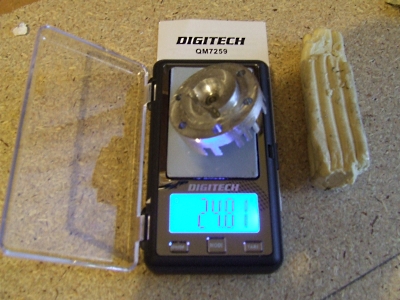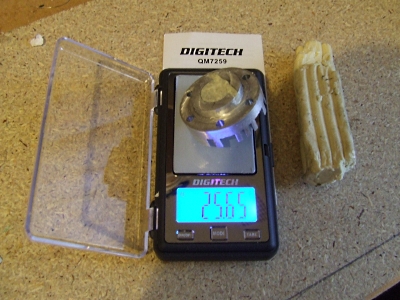|
The way fuel burns in a model engine is determined,
principally, by the amount the fuel/air mixture is compressed,
and, secondarily, by the shape of the head.
The measurement of compression ratio has been a bit of an
elusive target for me over the years. One needs to know
the volume enclosed above the piston at top dead centre.
My F3D associates attempt to determine this using liquid
injected in thru the gloplug hole. The volume concerned is only
about 0.5ml, so a finely graduated hypodermic is needed.
However, one needs to be able to see the fluid when it fills to
the level of the plug hole. Call me an idiot, but I can't see the
liquid!! So a better method to suit my failing sight was required.
Quite by chance I saw that Jaycar Electronics were selling
electronic scales for only about $60, which to my mind is
cheap. They weigh to 100g with a resolution of 10 milligrams,
which got my mind thinking.
So I bought a scale and weighed a 46 head, as shown in photo 1.

The reading was 24.81g. Then I worked some plasticene until it
was soft, and filled the head space with it. Re-weighing gave
25.65g, so the mass of plasticene in the head was 0.84g. Note
that I shaved off the plasticene across the squish band with a razor
first, and fitted a dead gloplug in place. (photo 2)

Then I dropped a weighed lump of plasticene into a measuring
cylinder to find its volume by displacement of water. This gave
a density of 1.395 g/cc for the plasticene. So the volume of the
combustion chamber was 0.84/1.395 which is 0.602cc.
This is a much easier way to determine head volume than with the
syringe, takes moments and is accurate enough. The volume
between the piston crown and squish can be found from the bore
and piston squish distance, using the formula for volume of a
cylinder, which is pi * (bore/2)^2 *(piston-to-squish)
My first result was obtained on my Enya 45, which I had arbitrarily
decompressed with a thick shim and run on 30% nitro. I was
amazed to find the motor was running fine on only 4:1 compression
ratio! Taking out the shim raised the comp to 5:1, with a gain of a
few 100 revs. Fitting another head gave 7:1 compression ratio,
and a total gain of 500 revs, to 7500 static. Worth having!
Note that I did not use the swept volume for these calculations, only
the volume swept after the exhaust closed. On another engine, running
FAI fuel, I found a much higher figure of 15:1
It would seem that Nitro has some remarkable properties!
Also, it may be worth watching the air density and adjusting the
compression ratio to suit! But that is a story for another day.
|